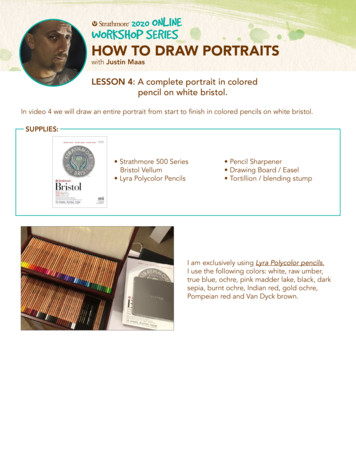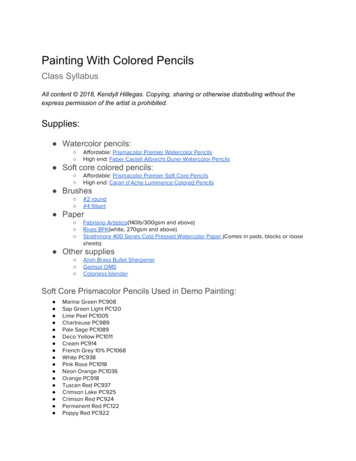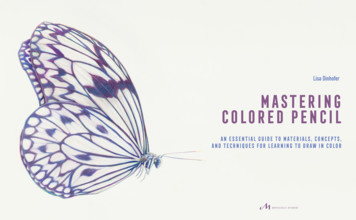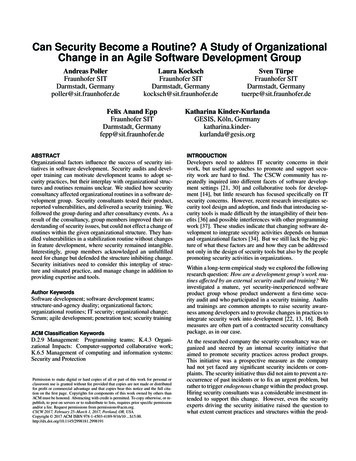Colored Pencil Primer - Sherrycamhy
MATERIAL WORLDGetting the most out of drawing mediaBY SHERRY CAMHYColored PencilPrimerPerhaps no other drawingmedium has seen its stock riseso dramatically in recent yearsas colored pencil. The mediumhas only lately been adaptedfor use by fine artists, but coloredpencil artworks are now purchased bycollectors and exhibited in museumsthe world over. If you love drawingand love the feeling of a pencil in yourhand, colored pencil might be worthexploring.Colored pencil goes by severalnames, including pencil crayon andcrayon de couleur. Whatever it’s calledthe medium is typically composed ofpigment or dye and a cellulose-gumbinder compressed with a base of either paraffin, beeswax, vegetable gum20 Drawing / Winter 2015or oil into a hard, dry cylinder encasedin a wood holder.Although the colored pencil as wenow know it is a fairly modern invention, evidence of these materials hasbeen found in ancient Egyptian, Roman and Greek art, as well as in primitive art on cave walls. Similar materials were molded into crayon formin the 15th century, and in the 1800sbasic colors were first incorporatedinto wooden writing pencils. In the1920s more and better pigments wereintroduced into their manufacture, butit was only in 2003 that the AmericanSociety for Testing and Materials published lightfastness standards for themedium, with which many manufacturers now comply.Sistersby Bill Vuksanovich, 2006, colored pencil and Neropencil, 36 x 33. Courtesy Forum Gallery, New York,New York.DR AW INGM A G A Z INE .C OM
Portraitby Sherry Camhy, 1997, colored pencil on Mylar, 10 x 8.I drew this portrait on transparent Mylar. In the photo at left, the drawing was placed over black paper.At right, it was placed over red paper.In response to growing demand,manufacturers now make numerousvarieties of colored pencils. Gradesrange from student (the least expensive) to museum-quality (more expensive and longer lasting). Many sizesand shapes are available, as are variouslevels of transparency, hardness, solubility, erasability and water resistance.Some colored pencils are wax-based,others oil-based. Wax-based pencilstend to be less expensive but moredifficult to erase, layer and blend thanoil-based pencils. Wax- and oil-basedpencils can usually be used together,and both come in a large range oftranslucent colors.Colored pencils are lightweight andconvenient for quick sketches but alsocapable of creating rich color, intricatedetails and complex painterly images. Here, we present a brief guideto this relatively new medium, withadvice about color layering, choosinga surface and techniques that can beused to explore colored pencil’s manysurprising possibilities.DR AW INGM A G A Z INE .C OMCOLOR AND L AYERINGMany pencil colors are made fromseveral pigments combined into onehomogenized color and then givenimaginative descriptive names. It isan advantage of the medium that theSwatches of yellow-orange and blue-green coloredpencil layered over each other on (from top) white,black and blue paper.colors are premixed and consistent;the accompanying disadvantage is thatit can be difficult to find a pencil ofthe exact color you need. Other colorsare achieved through layering, placingone color over another until the resultcomes as close as possible to the desired color and value.The challenge, then, is to know theeffect that layering particular colorswill produce. What will an intense,warm, medium-value yellow-orangelook like when layered over a cool,light blue-green on black paper? Theanswer in any given case depends onthe individual elements of each pencil’s color, such as hue, value, intensity, temperature and opacity. You canalways test pencils on a surface similar to the one you’ll be using for yourfinished drawing, and with experienceyou’ll become better at predicting theresults of layering different colors.But it also helps to know some broadprinciples of color layering. A few ofthe basics:l Layering complementary colorsdarkens both colors and reducestheir intensity.l Pressing harder intensifies a hue butdoes not darken it.l You can darken a color by layeringits next-darkest neighbor over it, forinstance, purple over red. Use darkbrown or dark blue before black, andavoid leaving black as the top layer ofany color.l To lighten a color, layer over it with alighter hue of the same color beforeresorting to white.l To intensify a color, blend it using atortillon or stump.l Burnishing any color with white willmake it lighter, shinier, cooler andhazier.The number of layers possible withwax-based colored pencils is limited bythe amount of wax buildup that occursin the layering process. At a certainpoint the wax surface will not allowmore pigment to adhere to it, althoughthin amounts of workable fixative canDrawing / Winter 2015 21
MATERIAL WORLDColored pencil scribbles on black paper.be applied to create a new surface.Wax buildup may lead to “wax bloom”(a hazy gray film) around 4 to 7 daysafter a drawing is finished. This canusually be buffed away, but it mayreturn unless you protect the drawing with fixative. Fixatives alter somecolors, so before you apply it to yourdrawing, you may want to do a quicktest by spraying half of a test sheet, letting it dry and comparing the sprayedand unsprayed portions.different toned backings to producedifferent effects. You can create a basicvalue drawing on one side of a sheet ofMylar and then add color to the otherside. Multiple layers of Mylar imagescan be matted together with interesting results. You can also use Mylar to22 Drawing / Winter 2015COLORED PENCILTECHNIQUESSgraffitoWhen a surface is covered with layersof wax-based colored pencil, a scratchboard or sgraffito technique is possible.Carefully use a razor blade or sharptool to scratch through the top layer ofpencil to redraw and create highlightsand textures by revealing the layers ofpencil or the original surface below.SURFACESColored pencil can be used on a rangeof surfaces. A smooth surface invitessharp detail and delicate color. Arough surface will hold more pigment.A medium-white surface gives the finegrainy texture often associated withcolored pencil. Toned paper intensifiescolor harmonies. Watercolor papersmake it possible to add wet media.Illustration board, prepared wood andcanvas allow colored pencil drawingsto more closely resemble glossy oilpaintings.One especially versatile option istranslucent Mylar. A drawing done onMylar can be exhibited with light flowing through the image or mounted ontest colors by placing a Mylar sheet ontop of your drawing and experimenting with different colors, allowing youto preview the results of a color mixture without risk to your drawing.EmbossingYou can make grooves in the surfaceof the drawing using a pointed chopstick, the sharpened end of a woodenpaintbrush handle, a metal skewer ora fingernail. These impressed markswill remain blank and crisp when theareas surrounding them are gentlycovered with colored pencil.ResistHomage to Leonardoby Dennis Angel, 2014, colored pencil, 40 x 22.Many colored pencils are water resistant. If you apply them to part but notDR AW INGM A G A Z INE .C OM
Monkeyby Sherry Camhy,1996, colored pencil,15 x 15.all of a drawing, you can then applywatercolor, ink or other wet media,which will be absorbed only in thoseareas that lack water-resistant pencil.MaskingApplying artist tape or painter’s tapearound an area to keep it clear ofcolor results in crisp edges when thetape is removed.Encaustic BlendingResting a drawing made with severallayers of wax-based colored pencil ona warm surface such as a hot waterbottle, heating pad or encausticpainting device will soften the wax.You can then use a paint pusher,blender or finger to manipulate thecolor with painterly results.SolventOil-based colored pencils make iteasier to use more levels of intensecolor. The layers can be safely
MATERIAL WORLDFour swatches of red oil-based colored pencil. The swatches were, from left to right, intensified by drawingwith strong pressure, burnished with a colorless blender pencil, drawn over impressed lines, and spreadwith turpentine.smoothed, mixed and spread thickor stretched thin with the use ofblenders and solvents. These include turpentine and mineral spiritsalone or combined with cold-pressedlinseed oil, as well as Liquin. If usingsolvents, your surface must first beprotected with gesso, rabbit-skin glueor gelatin size. (To prepare a gelatinsize, soak half a package of gelatinin one pint of water, heat slowly forabout two hours, and apply at roomtemperature to any absorbent surface.Wait six or more hours before use.)ErasingErasing is an iffy option with coloredpencil. Wax-based pencils are usuallymore difficult to erase than oil-basedones. To allow flexibility, it’s oftenbest to begin an image by establishingthe composition with the tentative useof a middle-value colored pencil—avoid starting with graphite.Oil-based pencils (top color strip) are often moreerasable than wax-based pencils (bottom strip).Yellow Leafby Sherry Camhy, 1997, colored pencil on cardboard, 24 x 20.Rubbing with a kneaded eraser willoften smear pigments, possibly making a problem worse, although withpractice that smudging technique canlead to pleasant effects. A kneadederaser can be used to lift excess colorfrom an area by stretching a cleaneraser thin, placing it gently downon the area and quickly pulling it up.Frisket film, Scotch tape and makingtape work similarly, but artist tape issafest. A plastic or electric eraser mayremove enough pigment for the drawing to be reworked. If the artwork hasbeen done on heavy prepared paperor board, an area can be sanded andresurfaced. vReprinted from Drawing Winter: Copyright 2015 by Interweave, a division of F W Media, Inc. All rights reserved.24 Drawing / Winter 2015 DR AW INGM A G A Z INE .C OM
as colored pencil. The medium has only lately been adapted for use by fine artists, but colored pencil artworks are now purchased by collectors and exhibited in museums the world over. If you love drawing and love the feeling of a pencil in your hand, colored pencil might be worth exploring. Colored pencil goes by several
type of colored pencil requires layering but you can fill the tooth of the paper if you work too hard or add too many layers too quickly. Go slowly, go softly and build up your drawing. I begin the block in but not with a traditional graphite pencil. Since this is a colored pencil drawing, we will do the block in using a colored pencil. If you use
Latin Primer 1: Teacher's Edition Latin Primer 1: Flashcard Set Latin Primer 1: Audio Guide CD Latin Primer: Book 2, Martha Wilson (coming soon) Latin Primer 2: Student Edition Latin Primer 2: Teacher's Edition Latin Primer 2: Flashcard Set Latin Primer 2: Audio Guide CD Latin Primer: Book 3, Martha Wilson (coming soon) Latin Primer 3 .
colored pencil; crayola multicultural colored pencils; crayola write start colored pencils, crayola colored pencils classpacks; crayola colorsticks classpack; crayola dry erase colored pencils; crayola my first colored pencils, crayola portfolio colored pencils; crayola gel f/x pencils; crayola graphite
1.Types of Colored Pencils a. Before we get into colored pencil techniques, let’s go over types and varieties of colored pencils. b.There are dozens of brands of colored pencils, some very affordable, costing 10-20 cents per pencil, and others on the higher end costing more than 5 a pencil. c.
pose a method for creating colored pencil style images. The feature of colored pencil drawings is that, though colored pencil drawings are drawn with limited number of colors of pencils, we can express a lot of colors and gentle textures by changing the strengths when drawing strokes and by overlapping strokes of different colors. In
colored pencil, but it’s really difficult, so this pen is great. I would recommend a two types of colored pencils: for the thinner parts and hair use the harder colored pencils such is Faber-Castell and for creating a smooth textures (smooth surfaces, larger areas) use a soft colored pencil such is Prismacolors. It’s easier if you use
Colored Pencil Reference Book One of the most useful tools in my own studio is the colored pencil reference book. I devel-oped it to solve a basic problem I was having. I like to work my pencils down almost to the nib, and thereby sharpen away the pencil’s col-or name and reference number. When I found
Software development is a source of security vulnerabilities. Software-developing organizations therefore need to pay at-tention to security and apply secure development practices. However, managing software development is a challenge in itself even without the added complexity of security work. Agile methodologies like Scrum are commonly .























